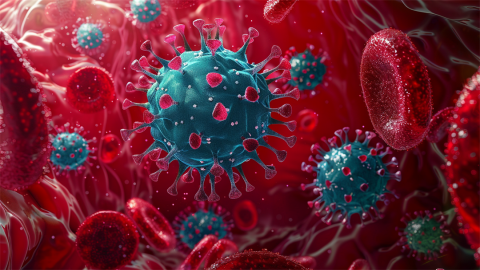How did AIDS come about?
The origin and transmission of AIDS are generally associated with cross-species transmission, sexual contact, blood transmission, mother-to-child transmission, and sharing of injection equipment. If abnormalities occur, timely medical consultation is recommended. Detailed explanations are as follows:

1. Cross-species transmission: The precursor of the AIDS virus is the simian immunodeficiency virus found in primates in Africa. During hunting, slaughtering, or close contact with primates, these viruses can enter the human body through broken skin or mucous membranes. After multiple mutations and evolution, they gradually transformed into the human immunodeficiency virus (HIV), capable of spreading among humans.
2. Sexual transmission: Unprotected sexual activity is one of the main routes of HIV transmission. During sexual activity, the mucous membranes of the genital organs are in a fragile state, allowing the HIV virus to enter the partner's body through tiny breaks. High-risk sexual behaviors, whether between same-sex or opposite-sex partners, including vaginal intercourse, anal intercourse, and oral sex, all carry infection risks. Anal intercourse poses a relatively higher risk of infection due to the thin and easily damaged rectal mucosa.
3. Blood transmission: Receiving blood or blood products contaminated with HIV, or using injection equipment, acupuncture needles, razors, or other medical or personal items that have not been strictly sterilized can lead to viral transmission. In areas with poor medical conditions and inadequate hygiene regulation, cases of HIV infection through blood transfusions have occurred. Among drug users, sharing injection equipment significantly increases the risk of HIV transmission within this population.
4. Mother-to-child transmission: Pregnant women infected with HIV may transmit the virus to the fetus or infant during pregnancy, childbirth, or breastfeeding. During pregnancy, the virus can enter the fetal body through the placenta; during delivery, the fetus may become infected through contact with maternal secretions containing the virus in the birth canal; during breastfeeding, infants may also become infected by consuming breast milk containing the virus.
5. Transmission via shared injection equipment: Among drug users, sharing unsterilized injection equipment among multiple individuals is a significant cause of HIV transmission. Trace amounts of blood remaining in the syringes may contain HIV. When different individuals use the same syringe, the virus enters the new host's body, leading to rapid spread of HIV among drug users and potentially causing co-infections with other bloodborne diseases such as hepatitis B and hepatitis C.
In daily life, it is important to establish correct sexual concepts, practice safe sex, reject drugs, and avoid sharing personal items that might come into contact with blood. When undergoing medical procedures, choose正规 medical institutions. Pregnant women should undergo prenatal screening and, if infected with HIV, promptly receive mother-to-child transmission prevention treatment to jointly prevent the spread of AIDS.









